Corsair H50 Liquid-Cooling System Review

We are going to discuss another compact and affordable liquid-cooling system for the CPU. This time it is a solution from Corsair.
This spring we tested a compact liquid-cooling system from CoolIt called Domino, which was priced at only $79. Well, this seemed like a great idea to quite a few makers and today we would like to introduce to you another inexpensive liquid-cooling system. It is called Corsair Hydro Series H50 (or simply Corsair H50) and is made by the company, which is primarily famous for their wide range of memory products.
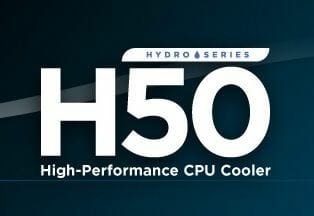
According to the developers, this liquid-cooling system outperforms a highly efficient air cooler by about 7 °C under 100$ CPU utilization (with an Intel Core i7-965 3.46 GHz frequency and 1.3 V Vcore), although they do not mention the particular cooler they actually imply here. We can easily name the competitor to this cooling system, meet with it up close and personal, test its cooling efficiency and acoustic performance and this way answer the following question: will a mass production liquid-cooling system priced at $80 outperform an air cooler? Well, let’s check it out now.
Package and Accessories
Corsair H50 liquid-cooling system ships in a dark-colored box with the picture of the cooling system on one side and the description of its technical specifications on the other:
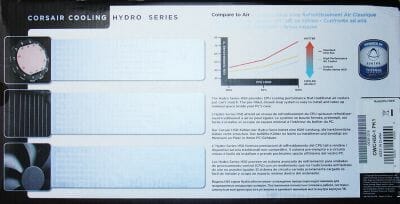
There was a clear plastic blister inside that contains the actual cooling system and all accessories.Corsair H50 comes with three retention kits for Socket AM2(+)/AM3, LGA775 and LGA1366 including corresponding backplates and four screws with washers.
Besides, the accessories bundle also included two brief installation manuals in six languages and one full user manual in English.
Corsair H50 is a fully ready liquid-cooling system. By “fully ready” I MEAN THAT Corsair H50 doesn’t need to be filled with coolant, because it comes prefilled and sealed. The system consists of three components: radiator with a fan, water block with a pump installed on it and two sturdy tubes, each 300 mm long, connecting the two first components together.
Radiator
The cooling radiator is made of aluminum and measures 151x120x27 mm.It is of classical design: there are 11 flat heatpipes (1.5 mm) with a corrugated band soldered to them. The mesh is about 1 mm wide.
The distance between the two neighboring channels is only 8.5 mm. you may think that a fan with high static pressure is required to blow the air through this dense meshed structure, or maybe even a pair of fans. However, there is no need for that for one simple reason: the effective radiator thickness is only 15 mm! It is almost weightless even though it is already filled with coolant. The total weight of the entire cooling system doesn’t exceed 700 g.
Pump and Water Block
There are two fittings coming out of the radiator with tubes in spiral cords pressed tightly against them. These cords prevent the tubes from bending during installation and use. The other ends of these tubes to into the pump and water block unit measuring 72x72x56 mm.
The water block base is already covered with a layer of highly efficient (according to the manufacturer) thermal interface based on aluminum oxide.
The base is very even and the smeared imprint results from the fact that during installation and removal of the water block you have to turn it. But we are going to dwell on it a little later. Right now let’s check out the finish quality of the water block base.
It is polished quite OK, although those who love mirror-shining surfaces will hardly be pleased this time. Therefore, some may want to polish it off themselves.
The water block and pump are originally made by Asetek, as you can clearly see from the company name and logo on the side of the pump.
“LCLC” abbreviation stands for “Low Cost Liquid Cooling”. There are a few cooling solutions manufacturers out there who use this platform already. Its specifications are described in detail on the official web-page.
After opening up the water block I saw that it consisted of four parts: plastic lid, the actual pump, plastic base with two fittings of different diameter and copper base plate (of the water block).
Of course, once you open up the water block you disturb the leaktightness of the system. However, if you act cautiously, do not drain the coolant (hold the system vertically) and have extra 40-50 ml of distilled water handy, then you should have no problems. In return you will be able to enjoy the beauty of the water block internal structure.
In fact, its design is fairly simple, as it consists of a copper base with micro-channel ribbed structure covered with some material, which looked like cloth (must be some sort of plastic).
It operates in a very simple manner: coolant is being pumped in on one side and pushed out on the other. There are special sealing rubber rings between the water block, plastic cover and the main pump block. These rings prevent any coolant leakages. The coolant consists of distilled water with anticorrosion additive (propylene glycol).
You can see the magnetic motor coil and controller circuit board on one of the sides of the block.
The pump is powered from a 12 V three-pin mainboard connector and consumes maximum 2.5 W. According to monitoring data, the pump rotor rotates at 1410-1440 RPM. The pump bearing should last around 50,000 hours according to the manufacturer warranty. The level of noise shouldn’t exceed 28 dBA.
Fan
Corsair H50 comes with a single seven-blade fan measuring 120x120x25 mm.
Although it is of solid black color and doesn’t bear any info about its original manufacturer, we managed to find out that it was made by Yen Sun Technology (YS Tech). In fact, we have already tested this exact fan (KM121225LB) under Akasa brand name in our article called “Be Cool: Ultimate 120/140 mm Fans Roundup”.
The fan uses double ball bearing with 80,000 hours MTBF. The fan rotation speed controlled by pulse-width modulation method (PWM) in our case varied from 720 to 1650 RPM. The level of noise generated by the Corsair H50 fan is not mentioned anywhere in the official specs, and there are no data in the YS Tech specs for this particular fan model with this rotation speed and PWM control option.
Compatibility and Installation Tips
This cooling system is compatible with all contemporary platforms except LGA1156. It uses same type retention kits with backplates for all of them. The backplates need to be stuck to the back of the mainboard PCB, while the actual retention frames are installed from the front.
Note that they are screwed on slightly, not tightened up.To install the radiator with the fan inside the system case, there should be a spot for a 120 mm fan on the back of the case. This is where the fan of Corsair H50 and radiator go into. They are attached with four screws with washers beneath them from the outside of the back of the system case.
On the photo above the fan is installed for air exhaust. However, it is just one of the options we checked out. According to Corsair’s instructions and overall heat transfer principles, the fan should be installed so that the air flow is directed towards the radiator and not away from it. True, our preliminary tests showed that with the fan installed the wrong way (with the air flow directed away from the radiator), the liquid-cooling system cools the CPU 4-5 °C worse than in case the air flow is directed towards the radiator. However, in the latter case the air flow structure inside the system case will be completely disturbed, because the fans on the back of the system case are mostly working for air exhaust. So what shall we do?
To solve this problem Corsair suggests that we should change the airflow structure inside the system case ousting hot air either through the top of the case (if there is a corresponding fan there), or through side, bottom or front (also if there are appropriate fans). In any case, we believe it is not a very smart solution at least because the warm air from the liquid-cooling system will have to go through the entire case heating up all other components on the way. Moreover, no one can guarantee that Corsair H50 users will have a flexible system case that allows changing the airflow structure so freely.
Why couldn’t they simply include eight short screws with the bundled accessories, so that the radiator could be installed into the spot for the 120 mm fan and then the fan attached on top of it? The radiator may fit just fine into this spot, because in most cases there is more free room along the back of the case than just for a 120 mm fan. It would be even better if they included two fans for the radiator: one for air intake and one for air exhaust… but we are going to talk more about it during our test session. For our tests we decided not to change the in-case airflow dramatically but simply removed the side panel of our Antec Twelve Hundred system case.
The last thing during the fairly simple installation procedure for Corsair H50 is the installation of water block and pump unit. The water block must be inserted into the retention frame slots and turned slightly (this is where the smeared thermal compound imprint comes from). After that you can tighten the screws to the end.
That’s all. You could also add another fan and replace the default one with a more efficient fan as well.Corsair H50 is priced at $80. It comes with a two-year warranty.
Testbed and Methods
All tests were performed inside a system case with the side panel removed. Our testbed was identical for all coolers throughout the test session and featured the following configuration:
- Mainboard: ASUS P6T Deluxe (Intel X58 Express), LGA 1366, BIOS 1701;
- Processor: Intel Core i7-920, 2.67 GHz, 1.25V, 4 x 256 KB L2, 8MB L3 (Bloomfield, C0);
- Thermal interface: Tuniq TX-2;
- Graphics card: ZOTAC GeForce GTX 260 AMP2! Edition 896 MB, 648/1404/2108 MHz (1030 RPM);
- Memory: DDR3 PC3-12800 3 x 2 GB OCZ Platinum Low-Voltage Triple Channel (Spec: 1600MHz / 7-7-7-24 / 1.65 V);
- System HDD: Western Digital VelociRaptor (SATA-II, 300 GB storage capacity, 10,000 RPM, 16 MB cache, NCQ);
- Backup HDD: Western Digital Caviar Green WD10EADS (SATA-II, 1000 GB, 5400 RPM, 32 MB, NCQ);
- Scythe Quiet Drive 3.5” HDD silencer and cooler chassis;
- Optical drive: Samsung SH-S183L;
- System case: Antec Twelve Hundred (front panel: two Noiseblocker NB-Multiframe S-Series MF12-S1 fans at 900 RPM and Scythe Gentle Typhoon fan at 900 RPM; back panel: one Scythe Slip Stream 120 fan at 900 RPM; top panel: standard 200 mm fan at 400 RPM);
- Control and monitoring panel: Zalman ZM-MFC2;
- Power supply: Zalman ZM1000-HP 1000 W (with a default 140 mm fan).
During this test session we managed to overclock our 45nm quad-core processor with the leveled out heat-spreader surface using 21x multiplier and enabled “Load-Line Calibration” to 3.95 GHz using the weakest cooling system of the today’s testing participants with the fan working in quiet mode. The nominal processor Vcore was increased to 1.35 V in the mainboard BIOS.
The memory voltage was at 1.62 V and its frequency was around 1500 MHz (7-7-7-14_1T timings). All other parameters available in the mainboard BIOS and connected with CPU or memory overclocking remained unchanged (set to Auto).
All tests were performed under Microsoft Windows 7 Ultimate RTM x64. We used the following software during our test session:
- Real Temp 3.30 RC11 – to monitor the processor core temperature;
- Linpack 64-bit with LinX shell version 0.6.3 – to create maximum CPU load (two test cycles, 5 Linpack runs in each cycle with 3584 MB RAM capacity involved);
- RivaTuner 2.24 – to visually control temperature changes (with RTCore plugin).
- CPU-Z 1.52.2 – to monitor processor core voltage and frequency.
The workload was created with two consecutive Linpack runs with the settings described above. The additional tests showed that increase in the memory capacity used by Linpack x64 causes minimal increase in the peak CPU temperature, which occurs only at low fan rotation speed of the liquid-cooling system (800 RPM). In other words, we chose sufficient amount of memory for our tests with Linpack x64 as well as sufficient number of iterations. You can see it clearly from the screenshot taken right after we completed the test, namely the RivaTuner graph with automatically marked maximum processor temperature. We reach peak temperature on the second iteration already and the next three iterations didn’t heat up the CPU any more.
The stabilization period for the CPU temperature between the two test cycles was about 8-10 minutes. We took the maximum temperature of the hottest processor core of the four for the results charts. Moreover, we will also provide the temperatures of all cores in a separate table alongside with the calculated average value. The ambient temperature was checked next to the system case with an electronic thermometer with 0.1 °C precision that allows monitoring the temperature changes over the past 6 hours. During our test session room temperature varied between 20.8-21.1 °C. When we performed the maximum CPU overclocking tests with all participating liquid-cooling systems, the room heated up to 23.0 °C (the heater was on because of the cold weather outside).
The noise level of each cooler was measured after 1:00 AM in a closed room about 20 m2 big using CENTER-321 electronic noise meter. The noise level for each cooler was tested outside the system case when the only noise sources in the lab were the cooler and its fan(s). The noise meter was installed on a tripod and was always at a 200 mm distance from the cooler. To measure the noise we set the cooler onto a 45 mm stand made of polyurethane foam material on top of a desk. The lowest noise reading our noise meter device can register is 29.8 dBA and the subjectively comfortable noise level in these testing conditions was around 34.5-35 dBA. The fan(s) rotation speed was measured in the entire supported range using our controller by changing the voltage.
Corsair H50 will be competing against our reference super-cooler – Thermalright IFX-14, which base I have finally evened out and polished.
The cooler was equipped with two Thermalright TR-FDB-2000 fans working in moderate acoustic mode at 1000 RPM (±10 RPM) and at maximum rotation speed of 2000 RPM. The fan rotation speed was adjusted and monitored using the above mentioned controller. Corsair H50 was tested with the default fan as well as with two Thermalright fans, too.
Cooling Efficiency
Before we go over to the actual cooling efficiency tests let’s check how Corsair H50 performance depends on the fan rotation speed and the number of fans. To accomplish this we first installed only one Thermalright TR-FDB fan with the rotation speed changing from 800 to 2000 RPM with 100 RPM increment (±10 RPM). After that we added another identical fan installed for air exhaust from the radiator and repeated the entire test cycle one more time. The results are summed up on the following graph and table.
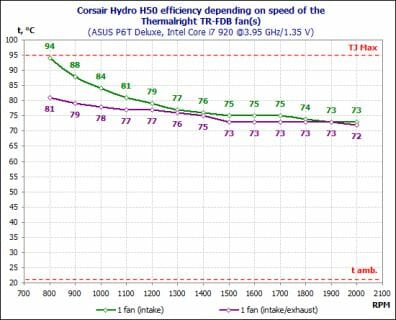
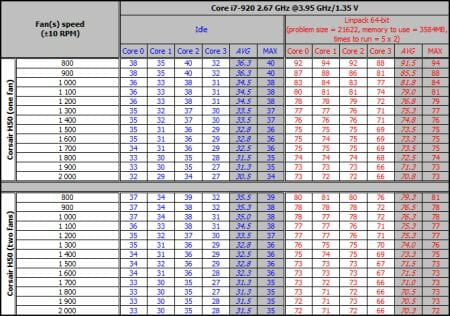
With a single fan the efficiency of Corsair H50 cooling system improves significantly in the rotation speed range from 800 to 1300 RPM. The lion’s share of this increase lies within 800-900-1000 RPM range, when the peak CPU temperature drops at first by 6 °C and then by another 4 °C. When the fan rotation speed increases from 1300 to 1500 RPM the temperature lowers only by additional 2 °C, while the speeding up from 1500 to 1700 RPM appears absolutely useless. By raising the fan rotation speed from 1700 to 2000 RPM we get an improvement of another 2 °C, which can’t make up for significantly increased level of noise.
With two fans installed onto the cooling system radiator for air intake and exhaust Corsair H50 immediately transforms. Its efficiency increases by 13 °C (!) at 800 RPM compared against the efficiency with only one fan and increases gradually up until 1100 RPM. When we increase the fan rotation speed from 1200 to 1500 RPM the CPU temperature under peak load drops by another 4 °C, while further rotation speed growth doesn’t affect the cooling efficiency any more, as it gets limited by small effective cooling surface of the radiator and the material used for it. The default fan of Corsair H50 works in the speed range from 720 to 1650 RPM – Corsair engineers must have studied the dependence of their system’s cooling efficiency on the fan rotation speed and had a justifiable reason not to equip their H50 with a more powerful fan. However, we don’t know why they didn’t include a second fan.
Now let’s compare the cooling efficiency of Corsair H50 against that of the best air cooler. We tested the liquid-cooling system with its default PWM fan as well as with a pair of Thermalright fans in two speed modes, and also in the same modes with the pump voltage lowered to 7 V. The CPU in this case is overclocked a little more than during the previous test session. So, here is a table with complete performance data and a summary diagram:
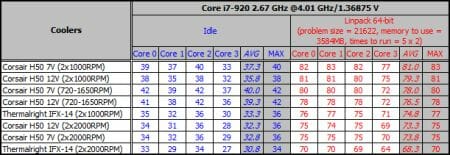
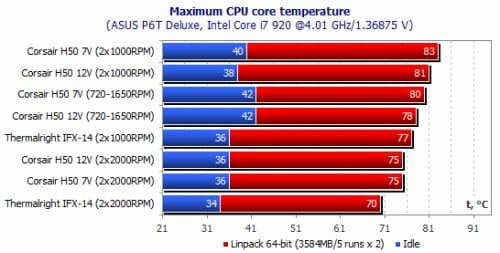
First of all we have to say that when the pump voltage was lowered from 12 to 7 V the efficiency of the cooling system dropped by no more than 2 °C and the already low noise level generated by the pump becomes absolutely minimal. At maximum fan rotation speed we see no dependence of the Corsair H50 cooling efficiency on the pump capacity, which primarily indicates that the radiator is the most important component of this particular cooling system. Therefore, we wish that Corsair H70 could have a 240 mm radiator preferably made of copper instead of aluminum. We didn’t test the pump MTBF at lower voltage within our today’s test session.
As for the comparison between Corsair H50 and Thermalright IFX-14, there is nothing unexpected here. The super-cooler was 4 °C ahead in quiet more and 5 °C ahead at maximum rotation speed of identical fans. Nevertheless, Corsair H50 turned out at least as efficient as the previously tested CoolIt Domino. IFX-14, which hasn’t been defeated yet, is stably 3 °C+ ahead of both competitors that is why we can admit that although Corsair H50 performed very well for an air cooler, it could have done better in liquid-cooling system terms.
In conclusion of our efficiency analysis let’s check out the maximum processor overclocking with two competing solutions participating in our today’s test session:
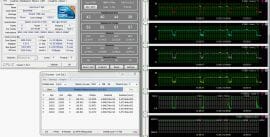
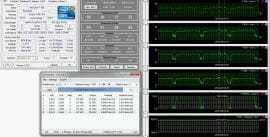
As you see, IFX-14 maintains the peak CPU temperature about 2-3 °C lower than Corsair H50 even at slightly higher frequency and Vcore (1.36875 V vs 1.375 V).
Acoustic Performance
For our acoustic performance analysis we measured the noise generated by the default fan of Corsair H50, its pump and one alternative Thermalright TR-FDB fan in the entire supported rotation speed range. During the tests all fans were installed onto the Corsair H50 radiator. Here are the results.
It is really surprising that if YS Tech KM121225LB fan doesn’t make any crackling noises, then it is quieter than Thermalright TR-FDB! Corsair H50 does work in a more acoustically comfortable sound spectrum than TR-FDB, but it was the pump that in fact amazed us most. Up until 12 V it stays within the subjective acoustic comfort zone and at 7 V you can hardly hear it at all. It is the quietest pump that we have ever tested in our lab. Excellent result!
Conclusion
Frankly speaking, I was pretty skeptical about Corsair H50 when I just started the review, because of all the previous experience I had with similar systems. However, I am glad that I was wrong, because this liquid-cooling system did surprise me in a very positive way and not just with one specific feature but with a combination of characteristics. I think no one is surprised at this point that a compact and inexpensive liquid-cooling system loses to the best air super-cooler, but the today’s difference turned out fairly small – only 4-5 °C, and simply negligible during maximum overclocking tests (60 MHz). At the same time Corsair H50 is very simple to install and work with, doesn’t require any special skills or knowledge from the user.
Corsair H50 pump is very quiet even at 12 V. By lowering the voltage to 7 V you can make it almost completely silent at the expense of only 2 °C increase in the maximum processor temperature. This fact together with a very successful (unlike Akasa) default fan makes Corsair H50 very appealing to those who care about the acoustic characteristics of their system case. Overall, I can conclude that Corsair H50 is the best compact liquid-cooling system I have tested so far.
It is impossible to address the operating life within a product review that is why the only thing I can tell you at this point is that it comes with a 2-year warranty. By simply installing the default fan of Corsair H50 for air exhaust and adding another fan for air intake on the opposite side of the radiator you can increase the cooling efficiency substantially. I am sure that any user, even a beginner will be able to do it. However, it could be nice if Corsair took care of that on their end, as in this case there would be no need to explain to users how to arrange the airflow inside their system case to ensure highest cooling efficiency.